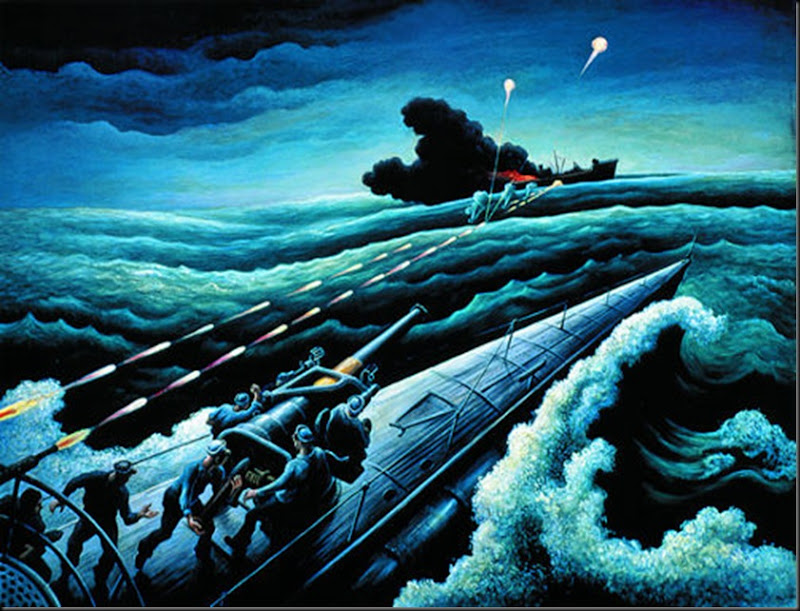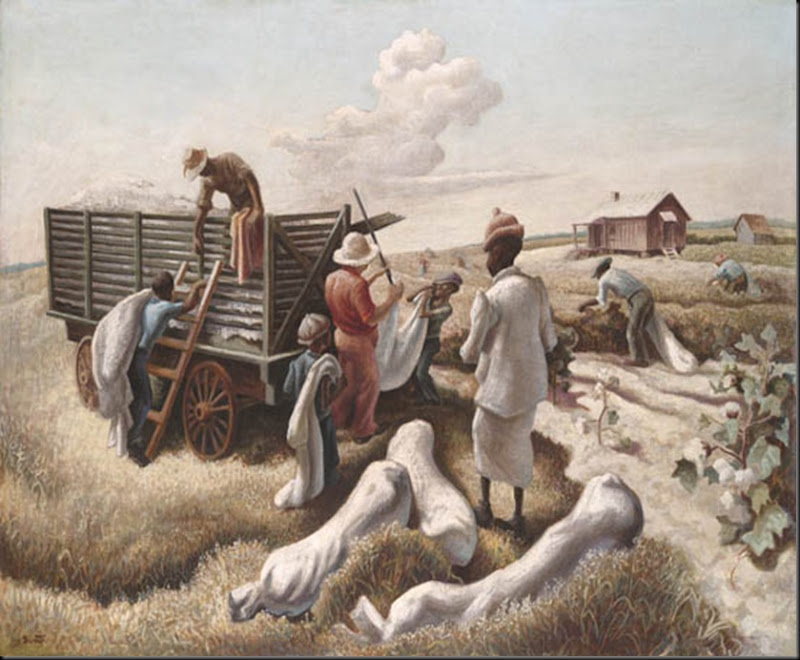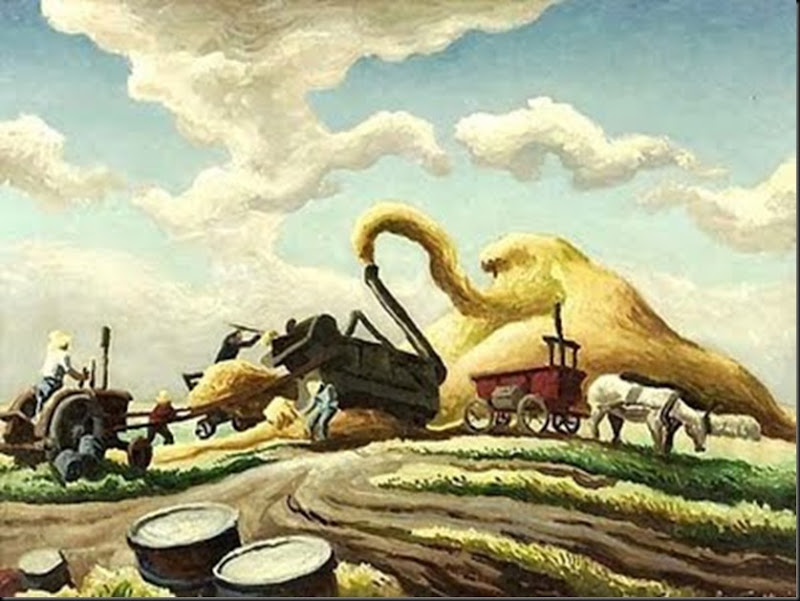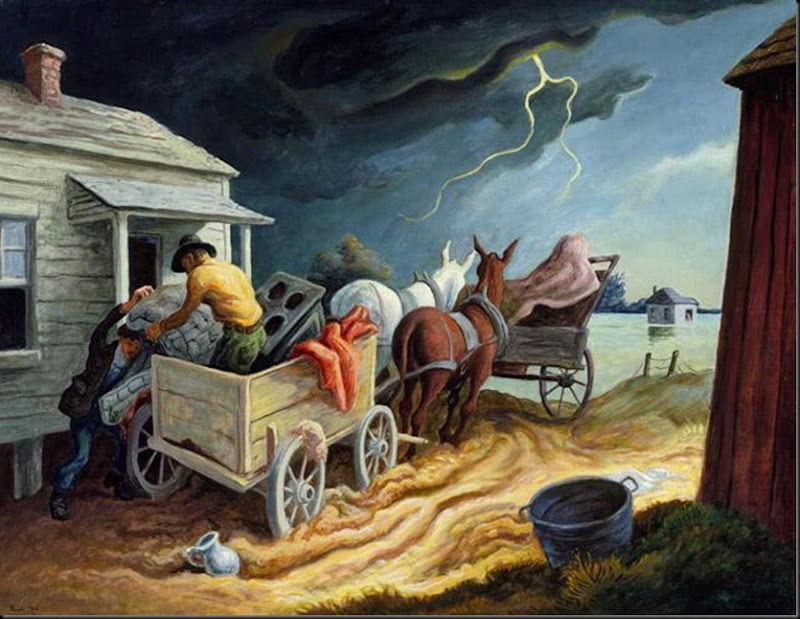Thomas Hart Benton is perhaps the best known muralist associated with the American Scene Painting movement of the 1930s. Benton's vivid, stylized portrayal of pre-industrial agrarian life and his later emphasis on the plight of the working class in the post-Depression era earned him a reputation as a social activist, and he gained publicity through public works projects. Within the broad American Scene Painting Movement, Benton is most closely associated with Regionalism a movement that rejected modernism in favor of a naturalistic and representational style. Regionalism gained recognition through public art works in highly visible locations such as banks, post offices, and political buildings. The Indiana Murals, Benton's most well-known and most controversial work, is exemplary of both the Regionalist style of painting and focus on social commentary. As part of the state of Indiana's contribution to the 1933 Century of Progress Exhibition in Chicago, Illinois, the Indiana Murals depict the oppressed farmers, Ku Klux Klan members, and big business as negative actors in society. After Benton's success with the Indiana Murals, he took a teaching position at the Kansas City Art Institute. For the rest of his career, Benton remained in the Midwest and focused on public murals, leaving a legacy that captured the character of the collision between agrarian life and industrialization in 1930s America.
Though Benton gained fame as an artist in cities such as New York, Chicago, and Paris, he was born in rural Neosho, Missouri. Despite his strong political background and the encouragment of his congressman father, Benton shunned politics in favor of art school. After a short stint as a cartoonist, Benton enrolled in the Art Institute of Chicago in 1907 and later transferred to the Academie Julian in Paris. In Paris, Benton met renowned Mexican muralist, Diego Rivera, whose use of vivid colors and portrayal of social realities would heavily influence Benton's style during the formative years of Regionalism. After returning from Paris in 1913, Benton took up a job as a draftsman for the Navy and switched from painting landscapes to sketching scenes from shipyard life. These early years as an artist, characterized by migration between disparate environments like the rural American Southeast, the Paris art scene, and the Naval shipyards, played an integral role in crystallizing Benton's view of the tension between cosmopolitan and agrarian life.
Back in the New York art scene during the 1920s, Benton taught at the Art Students League and began to gain acclaim for his his works that addressed the social realities of the city. Benton also became more directly involved in leftist politics, an association which may have directly spurred the works known today as part of the Regionalist movement. In many ways, Regionalism thrived in the wake of the American art renaissance at the turn of the century. The success of the Ashcan School (1910) demonstrated a uniquely American movement away from dependence on European art aesthetic and sought to claim a legitimacy for a strictly American art at the international level. American Scene Painting during the 1930s took up the challenge of the Ashcan School by depicting everday life in America in a representational, easily accessible style. Modern art historians generally consider Regionalism to be the subsect of American Scene Painting which deals more directly with the incorporation of art into the public hemisphere in order to evoke a nostalgia for pre-industrial America. Social Realism, the other subsect of American Scene Painting, places a heavier emphasis on art as a vehicle for political and social critique. Noted Regionalists include Grant Wood and Ben Curry, both contemporaries of Benton. These painters primarily gained publicity through federal art projects funded as part of Roosevelt's New Deal, and their works reflect the desire to appeal to a public aesthetic.
Benton eventually moved to Kansas City, where he painted some of his most well-known works such as the Independence Murals and the Truman Library, and where he lived for until his death in 1975. Benton's works during his years in Kansas City reflected his new environment: the beauty of the rural Midwest and the life of small farmers. At the same time, the relentless forces of American industrialization and capitalism made their way into Benton's works, and American icons of progress, railroads, city culture, and cars, begin to encroach on the Benton's idyllic pastoral scenes. Towards the end of Benton's life, he turned away from the role of social critic and produced more portraits and works for decorative purposes. Benton died in 1975, in his studio, but left a rich history of American culture and society during the 1930s and 40s in his wake.
















![Camera: DCS560C<br />Serial #: K560C-01102<br />Width: 3040<br />Height: 2008<br />Date: 6/28/00<br />Time: 9:30:46<br />DCS5XX Image<br />FW Ver: 3.0.9<br />TIFF Image<br />Look: Product<br />Antialiasing Filter: Installed<br />Tagged<br />Counter: [1484]<br />ISO Speed: 80<br />Aperture: f16<br />Shutter: 1/80<br />Max Aperture: f2.8<br />Min Aperture: f22<br />Exposure Mode: Manual (M)<br />Compensation: +0.0<br />Flash Compensation: +0.0<br />Meter Mode: Evaluative<br />Flash Mode: No flash<br />Drive Mode: Single<br />Focus Mode: One Shot<br />Focus Point: --o--<br />Focal Length (mm): 70<br />White balance: Custom<br />Time: 09:30:46.409<br /> Camera: DCS560C<br />Serial #: K560C-01102<br />Width: 3040<br />Height: 2008<br />Date: 6/28/00<br />Time: 9:30:46<br />DCS5XX Image<br />FW Ver: 3.0.9<br />TIFF Image<br />Look: Product<br />Antialiasing Filter: Installed<br />Tagged<br />Counter: [1484]<br />ISO Speed: 80<br />Aperture: f16<br />Shutter: 1/80<br />Max Aperture: f2.8<br />Min Aperture: f22<br />Exposure Mode: Manual (M)<br />Compensation: +0.0<br />Flash Compensation: +0.0<br />Meter Mode: Evaluative<br />Flash Mode: No flash<br />Drive Mode: Single<br />Focus Mode: One Shot<br />Focus Point: --o--<br />Focal Length (mm): 70<br />White balance: Custom<br />Time: 09:30:46.409<br />](https://blogger.googleusercontent.com/img/b/R29vZ2xl/AVvXsEiuKCmnlWxFu8gACWTZfaoctPR-pT5dKNhpeLBfPcKpuUp6h3umZl1StKK7Fc8AoEdZTh4f1hlX-HxY23UYgT1bAKFY14I1TG-vxcx7xGjfuRo6_QO3I-QladjEUtd6ubgNvmi4cGYE2U2P/?imgmax=800)
Very, very good. Grazie tante!
RispondiElimina